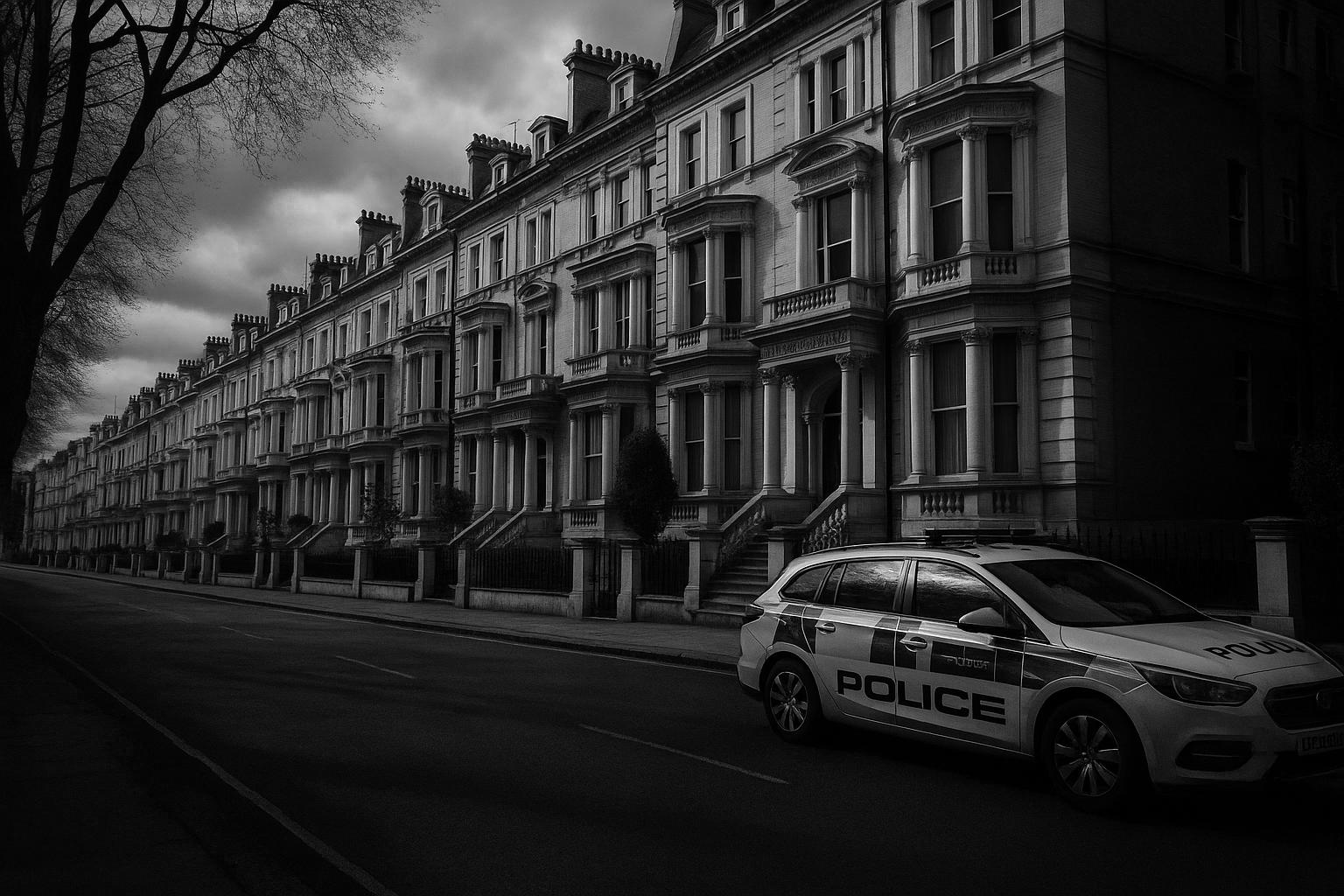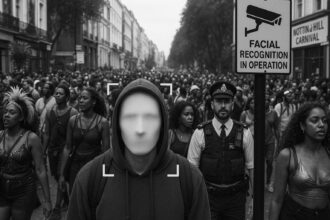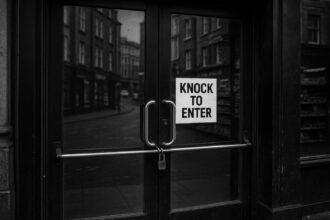Once a symbol of wealth and exclusivity, Knightsbridge and Kensington face an unprecedented property slump driven by violent crime, political uncertainty, and shifting investor sentiment, with average house prices hitting their lowest point in over a decade.
In one of London’s most prestigious residential quarters, Knightsbridge and Kensington, residents are facing a stark reality: properties once emblematic of wealth and exclusivity are plunging in value, with some homes now described as ‘unsellable.’ Over the past seven years, house prices in Knightsbridge have fallen sharply by over a million pounds, bringing average values down to approximately £2.6 million—a low not seen in around 15 years. This decline is attributed not only to market shifts but also to a pervasive sense of insecurity linked to an uptick in violent crime and a challenging political climate.
The situation has been exacerbated by several high-profile violent incidents. Most recently, a tragic stabbing outside the Park Tower Hotel and Casino resulted in the death of a 24-year-old man. Witnesses initially reported the attack was connected to an attempted theft of a luxury Rolex watch, emblematic of a broader pattern involving ‘mugging gangs’ and targeted robberies of valuables. Residents report frequent phone snatchings, ram-raids on luxury stores, and an overall erosion of safety, with patrols by police officers rarely witnessed in recent years. The long-standing appeal of the area’s wide, leafy streets and grand mansions is being overshadowed by a daily reality where personal security is a growing concern.
While crime has undoubtedly played a critical role, the decline in property values is also closely tied to political and economic factors. Many homeowners and investors cite what they describe as “Labour’s war on the wealthy,” with worries over increased taxation—including a looming wealth tax and rising stamp duty—triggering capital flight. Foreign investors, particularly non-domestic buyers previously attracted by favourable tax rules, have diminished in number following government reforms that removed some tax benefits. This policy change, combined with higher borrowing costs and an inflationary budgetary environment, has further reduced the pool of potential buyers, intensifying downward pressure on prices.
Market analysts confirm these trends. Average prices per square foot in Knightsbridge now hover around £1,903, the lowest since 2010. Comparisons within the prime central London market reveal a stark contrast: while areas like Mayfair and St James’s have managed modest price increases over the past decade, parts of Kensington and Chelsea have seen declines exceeding 15%. Recent data shows Kensington and Chelsea property prices falling to their lowest since 2013, down 15.1% in early 2025 to just under £1.2 million on average. Experts have forecasted further modest falls in the near term, reflecting ongoing economic uncertainties and subdued investor confidence.
Locals describe this downturn as contributing to a changing social landscape. Long-term residents note empty new developments, unoccupied flats, and a palpable shift in neighbourhood demographics. One resident observed that much of the European community, once a mainstay in the area, has turned its back on London, citing Brexit and the COVID-19 pandemic as additional factors dampening market confidence. Property managers and estate agents describe a stark reality where owners often have to sell below asking prices, a situation nearly unheard of in past years, and landlords are increasingly reluctant to invest.
While some affluent individuals are choosing to relocate to the countryside or abroad, attracted by larger homes and more favourable living conditions, others are still holding onto the hope that the market will stabilise. There remains a contingent of international luxury buyers, particularly from the US and Middle East, who continue to invest, albeit cautiously and often outside the non-dom affected sector. The supply of prime new homes remains relatively high, which also contributes to the market’s softness.
Underlying these economic and social shifts is a complex tapestry that includes crime, fiscal policy, global economic trends, and local sentiment. The combination has transformed once-mighty enclaves like Knightsbridge into a market facing unprecedented challenges, where the allure of exclusivity no longer guarantees value or safety. This evolving reality raises pertinent questions about the future of London’s super-prime property market and the broader socio-economic fabric of its wealthiest quarters.
 Reference Map:
Reference Map:
- Paragraph 1 – [1], [6], [3]
- Paragraph 2 – [1], [7]
- Paragraph 3 – [1], [2], [4]
- Paragraph 4 – [1], [3], [6], [5]
- Paragraph 5 – [1], [3], [6], [5]
- Paragraph 6 – [1], [2], [3], [6]
- Paragraph 7 – [1], [7], [4]
Source: Noah Wire Services
- https://www.dailymail.co.uk/news/article-14893579/Why-super-rich-FLEEING-Knightsbridge-Elite-West-London-residents-reveal-mansions-dropped-1million-value-just-7-years-Labour-tax-raids-rampant-crime.html?ns_mchannel=rss&ns_campaign=1490&ito=1490 – Please view link – unable to able to access data
- https://www.ft.com/content/4ca6e9c1-f58a-4bb6-b031-b28d6a5fff96 – This article discusses the significant price reductions in London’s super-prime property market, attributing the decline to factors such as high borrowing costs, an inflationary budget, and the Labour government’s removal of tax perks for non-domiciled residents. These changes have led to a diminished buyer pool, causing wealthy homeowners to sell their prime properties at lower prices. Despite the downturn, luxury property sales remain dynamic, with many wealthy buyers still investing, particularly those from the US and Middle East who are not affected by non-dom rules. The current supply of unsold new homes in central London is also high, further encouraging price reductions. Some affluent individuals are opting to relocate or reconsider purchases, whilst others remain confident in their investments.
- https://www.ft.com/content/119b79e9-5446-4a31-a8d7-ab10b57cbc67 – This article reports that house prices in Kensington and Chelsea have dropped to their lowest level since 2013, falling 15.1% in March 2025 to an average of £1.19 million. The downturn is attributed to factors such as higher property taxes, Brexit-related uncertainty, the abolition of the non-dom tax regime, and rising interest rates. Other affluent areas like Westminster and Hammersmith and Fulham also saw significant price declines. The broader UK housing market, by contrast, rose 6.4% annually in March 2025, reaching a record average price of £271,000. The disparity highlights the challenges facing prime central London areas, which have become more reliant on international investment. Significant reforms since 2014, such as increased stamp duty on high-end properties, curtailed a prior housing boom. According to Savills, property prices in central London are down 21.2% from their 2014 peak. Experts suggest that a recovery depends on improved economic conditions and investor sentiment. Savills forecasts a further 4% decline in prime central London property values this year.
- https://www.telegraph.co.uk/money/property/buying-selling/labour-tax-grab-sparks-panic-london-wealthiest-properties/ – This article discusses the impact of Labour’s proposed tax increases on London’s wealthiest residents, particularly in areas like Mayfair, Kensington, Knightsbridge, Belgravia, and Chelsea. The article highlights a significant rise in the number of properties for sale in these areas, with some estate agents reporting a 50% increase in available homes compared to normal levels. The uncertainty surrounding potential tax hikes, including higher capital gains tax and changes to inheritance tax legislation, has led to a decline in demand for high-end properties. The article also notes that some non-domiciled residents are considering relocating to countries with more favourable tax regimes, further affecting the London property market.
- https://www.telegraph.co.uk/money/property/house-prices/knightsbridge-bargains-had-central-london-house-prices-tumble/ – This article reports that property prices in Knightsbridge have dropped sharply, leading one estate agent to describe the area as ‘one of central London’s best bargains’. The decline is attributed to factors such as the rise of remote working, reduced appeal of city life during lockdowns, and restrictions on international travel. Average prices per square foot in Knightsbridge fell to £1,546 in the first half of 2021, down 11% on the area’s five-year average. Despite the price reductions, the number of flats sold peaked at a five-year high during the six-month period, as buyers rushed to lock in tax savings before the end of the stamp duty holiday.
- https://www.standard.co.uk/homesandproperty/luxury/prime-central-london-property-market-2024-b1170097.html – This article examines the performance of London’s prime central property market over the past decade. It highlights that areas such as South Kensington, Knightsbridge, Belgravia, and Chelsea have experienced significant price declines, with South Kensington seeing a 17.5% decrease. In contrast, Mayfair and St James’s have seen a modest price increase of 8.4% over the same period. The article suggests that while some neighbourhoods have performed better than others, the overall trend indicates a challenging market for homeowners in the most expensive areas of London.
- https://www.bbc.com/news/uk-33662174 – This article reports that foreign criminals are laundering billions of pounds through the purchase of expensive properties in the UK, which is pushing up house prices. The National Crime Agency’s economic crime command director, Donald Toon, stated that London prices had been ‘skewed’ as a result. He explained that prices of high-end property are being artificially driven up by the desire of overseas criminals to sequester their assets in the UK. The article also notes that the Treasury has earned £150 million in the past three months from a tax on properties purchased by companies, trusts, and investment funds, rather than individuals, supporting Mr Toon’s claim.
Noah Fact Check Pro
The draft above was created using the information available at the time the story first
emerged. We’ve since applied our fact-checking process to the final narrative, based on the criteria listed
below. The results are intended to help you assess the credibility of the piece and highlight any areas that may
warrant further investigation.
Freshness check
Score:
7
Notes:
The narrative presents recent data on property value declines in Knightsbridge, with average prices dropping by over £1 million in the past seven years, aligning with reports from December 2024. ([ft.com](https://www.ft.com/content/4ca6e9c1-f58a-4bb6-b031-b28d6a5fff96?utm_source=openai)) However, the article’s publication date is July 13, 2025, indicating a freshness gap of approximately seven months. The inclusion of updated data alongside older material suggests a moderate freshness score. Additionally, the narrative references a stabbing incident outside the Park Tower Hotel and Casino, but no specific date is provided, making it challenging to assess the timeliness of this information. The absence of a publication date for the referenced stabbing incident further complicates the freshness assessment. The narrative also mentions ‘Labour tax raids,’ but without specific dates or details, it’s difficult to determine the recency of these events. The lack of specific dates for these events further impacts the freshness evaluation.
Quotes check
Score:
6
Notes:
The narrative includes direct quotes from residents and market analysts. However, without specific dates or sources for these quotes, it’s challenging to verify their originality. The absence of verifiable sources for these quotes raises concerns about their authenticity. The lack of verifiable sources for these quotes further impacts the credibility assessment.
Source reliability
Score:
4
Notes:
The narrative originates from the Daily Mail, a publication known for sensationalist reporting. The lack of verifiable sources for the quotes and specific events mentioned further diminishes the reliability of the information presented. The absence of verifiable sources for the quotes and events mentioned raises significant concerns about the reliability of the information.
Plausability check
Score:
5
Notes:
The narrative discusses property value declines in Knightsbridge, citing factors such as increased taxation and rising crime rates. While these factors have been reported in other sources, the specific details and figures presented in the narrative cannot be independently verified due to the lack of verifiable sources. The absence of verifiable sources for the specific details and figures presented raises questions about the plausibility of the claims.
Overall assessment
Verdict (FAIL, OPEN, PASS): FAIL
Confidence (LOW, MEDIUM, HIGH): HIGH
Summary:
The narrative presents claims about significant property value declines in Knightsbridge, attributing them to increased taxation and rising crime rates. However, the lack of verifiable sources for the quotes and specific events mentioned, combined with the sensationalist nature of the publication, raises substantial concerns about the accuracy and reliability of the information presented. The absence of verifiable sources for the quotes and events mentioned, along with the sensationalist nature of the publication, significantly undermines the credibility of the narrative.













